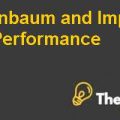
SIMON'S HOSTILE TENDER FOR TAUBMAN
- 1. As a Taubman Centers Inc. independent director, would you vote to accept the $20 per share offer? Why or why not? What alternative courses of action would you consider?
As an independent director of Taubman, I owe a responsibility towards our stakeholders to take decisions which are in their long-term benefit. Voting for the proposed offer will strongly depend on the bid price offered by Simon and the long-term vision of the trust.
A proposed share price of $20 represents a significant premium over the current share price of $14.5; we could counter that the offer with mixed cash and equity in parent (Simon) would be more beneficial. On the other hand, amalgamation with Simon seems to be an attractive project because the organization has large malls and shopping centers operating in United States. Further the latest teamed up with Westfield America Trust has increased investors’ confidence. If Taubman Centers has long term strategic vision to grow through horizontal diversification then, the Simon’s offer seems to be attractive.
Prior to voting for the proposed offer, I would like to look at comparable private market transactions; this is not always easy and requires a comprehensive valuation of every mall and shopping centre. Normally, the most commonly reported measurements used are Net Asset Value (NAV) and Adjusted Funds from Operations (AFFO). If results of using valuation model refer to a share price lower than the proposed offer then the offer will be financially viable, on the other hand if the model reports a share price higher than proposed then the offer would not be financially feasible.
- 2. How would you determine the company’s fair value? Please critique the Morgan Stanley analysis in Exhibit 9. Is the Morgan Stanley analyst using the “Right” cap rate? How does the cape rate compare to the company’s cost of capital, per CAPM?
Determining the company’s fair value is the most complex task, we could either use Net Asset Value (NAV) or Adjusted Fund from Operations (AFFO) model, sometimes referred to as Funds Available for Distribution (FAD).
NAV is the ratio of market value of equity to total number of outstanding shares whereas, AFFO can be calculated by starting with FFO and deducting existing properties’ capital improvement expenditures as well as amortization of debt principal.
Moreover, the Morgan Stanley’s valuation analysis in Exhibit 9 assumes a growth of 5% in EBITA and ignores the negative outlook of interest rate exposure, below average rental rates and impact of TCO’s newest properties. Additionally, using cap rate in valuation could be dangerous because REITs tended to be levered, small changes in cap rate assumptions could lead to large fluctuations in estimates of equity value.
Cap rate is the ratio between net operating income to property asset value, cap rate simply quantifies property value per dollar whereas cost of capital can be used to discount cash flow analysis to compute present value, so the cap rate allows us to value property based on single net operating income. However, the cost of capital requires discounting cash flow back to present value.............
This is just a sample partial case solution. Please place the order on the website to order your own originally done case solution.
The solution will also come with a separate excel file with calculations.













